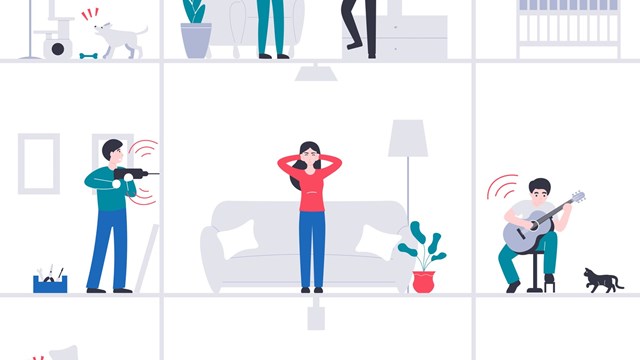When you live in a multifamily building, however, peace and quiet can be hard to come by. From the guy upstairs who gargles loudly at precisely 6:47 a.m. every morning to the neighbor with the yapping Chihuahua—at some point the soundtrack of your neighbors’ lives will inevitably intrude upon your own.
So what’s to be done about noise when your walls are paper thin and dozens of people may call a single building a home? Tackling noise concerns and complaints can be less intimidating if you hit it from both sides: preventing potential problems through construction and soundproofing techniques and implementing policies and community rules to control noise and encourage courteous behavior among residents.
Quantifying Quiet
According to Orlando E. Ballate, executive vice president of The Falcon Group’s Claims/Forensics Division in Bridgewater, New Jersey, “Noise complaints in multifamily buildings are one of the leading types of complaints to managers. The amount of complaints depends on a number of factors, such as type and quality of construction, location of the building and how considerate your neighbors are.” In problematic buildings, noise complaints can make up 30 to 40 percent of complaints to management, Ballate says.
Robert N. Andres, a technical advisor for the nonprofit group Noise Free America agrees, citing that from his experience that, “about 20 to 30 percent of complaints in close communities would be noise or vibration-related.” Combine poorly constructed walls between apartments and your neighbor dancing to Beyonce while wearing heels, and you’ve got yourself a chronic noise complaint.
How someone defines “noise” can be pretty subjective. One person's maddening racket is another's pleasant dinner soundtrack. In terms of complaints in residential spaces, noise is typically related either to individual actions like loud televisions, voices, music, heavy footfalls, barking dogs and raucous parties, or to related to equipment—things like air conditioners, lawn mowers, flushing toilets and running water.
In order to make noise levels a little less subjective, Ballate provides a scientific background to explain how sound is measured. “As a sound wave travels across a room and touches a wall, a reflective wave is produced that will reintroduce a portion of that wave back into the room. The balance of the original sound will attempt to pass through the wall to the adjoining room. The energy that survives this transfer is called sound transmission...the studs inside a common wall and the joists inside a common floor and ceiling assembly are pulling noise back and forth structurally before delivering airborne sound to the other side.”
In other words, noise is complicated. But tackling noise concerns and complaints can be less intimidating if you hit it from both sides: preventing potential problems through construction and soundproofing techniques and implementing policies and community rules to control noise and encourage courteous behavior among residents.
The Ruckus Stops Here...
A little prevention is worth an pound of cure, so if you have the time, budget and opportunity to silence noise before it starts, there are a number of measures you can take. According to Anthony R. Bontomase, an associate principal at the communications technology and acoustic consulting firm of Shen Milsom & Wilke LLC in New York, “There are no magic materials that can circumvent the laws of physics. There are specialty products available, and they do have value in limited circumstances, but usually it's better to stick with traditional materials and methods that contractors know how to install. Fixing noise problems is unique to the circumstance and the particular noise source; the propagation path and noise receiver will dictate what solutions are viable. The best approach is to be proactive and design to address common acoustic problems with a consultant, since remediation work is always more costly and time consuming than doing it 'right' the first time.”
Ballate suggests that building improvements such as “insulating partition walls with sound attenuation insulation blankets, adding additional gypsum boards to problem walls, replacing windows, requiring carpeting with thick padding on floors, and sealing any major gaps in floors and walls with acoustical sealant or caulk” can all help keep both the individual actions and equipment related noise at a less problematic level. According to Owens Corning, sound attenuation batt insulation are lightweight, flexible fiberglass insulation-based panels in various sizes designed to deliver noise control.
Unfortunately, chances are good that if you are reading this, you aren’t preparing to design and construct a soundproof residence from scratch. In that case, solutions that are more affordable are likely behavioral and managerial, rather than structural.
For example, “Associations in buildings with hardwood flooring can implement rules and regulations requiring carpeting or other sound-proof flooring throughout a certain percentage of each unit,” says Jennifer L. Alexander, a partner at the law firm Griffin Alexander PC, a law firm serving multifamily communities in New Jersey and New York City. “Associations can also adopt a resolution establishing quiet hours, or enforcement procedures for noise nuisances.”
Ballate agrees, recommending that associations “incorporate quiet times into community bylaws, such as between the hours of 10 p.m. and 6 a.m., where noise should be kept to a minimum.”
These regulations can be communicated at board meetings, in building newsletters and correspondence and casually amongst residents. There is no substitute for education, Andres says. “It’s surprising how little is known about how noise is transmitted and annoyance factors. Many times, people are making objectionable noise without even realizing it.”
Keeping Quiet
“I think the creation of condo bylaws with thoughtful acoustic requirements and/or acoustic review of renovations at least puts people on the path of conscientiousness,” Bontomase says, also suggesting the use of vibration isolation devices or sound attenuation devices like duct silencers, acoustic lining, and noise screens or replacing loud equipment with quieter units and models to make that path a little smoother.
Your association might be able to install some of these tricks and agree on designated quiet times, but should also be have a solid administrative infrastructure to handle inevitable rule breaking, complaints and penalty enforcement. What makes this challenging goes back to the subjective nature of noise. “One sensitive individual might find any walking across a floor from a neighbor above as intolerable, whereas another individual might not,” says Alexander. “The typical standard is that of reasonableness. What will most (more than 50%) of unit owners find to be an unreasonable noise level? It is often very difficult to ascertain, and is usually one of the main issues in trying to enforce noise ordinances.”
Ballate suggests that boards “perform a sound transmission study of the building to develop a plan of action for the entire building to reduce noise and improve the community’s quality of life.” And, if possible, removing the subjective human variable and putting the science of sound on your side can help set the building standards and regulations. “’Reasonable’ limits for noise in multi-unit residential units are set in Environmental Protection Agency (EPA) and Housing and Urban Development (HUD) guidelines,” explains Andres. From there, depending on the class of the residence, allowable levels are reduced during nighttime hours. As Andres explains, the overall limits are usually defined by the day and night average.
Once the guidelines have been set, noise regulations should be enforced just like any other policy. If residents are fined for not properly disposing of their garbage, they also should consistently also be punished for volume infractions. “Most associations are afforded a variety of remedies for violations of rules and regulations,” says Alexander. “They can include fines, loss of voting rights, and loss of the use of amenities and facilities, or even a lawsuit for injunctive relief.”
That said, “Such rules are very difficult to enforce,” she cautions. “Most times, I will advise my clients that noise issues are a ‘homeowner-to-homeowner’ dispute that should be resolved between the homeowners. The association is required by law to provide a forum for alternative dispute resolution for homeowners who wish to resolve their dispute as an alternative to litigation. If a homeowner requests such a hearing, the association should provide that forum.”
Further, explains Alexander, “The association should comply with its due process requirements by providing notice of the alleged violation to the unit owner and by providing an opportunity for a… hearing over the issue.” As mentioned before, the subjectivity of sound makes the legal proceedings a little tricky. “If challenged in court, the association would bear the burden of proving the noise was above and beyond that of a reasonable level, which with solely testamentary evidence is difficult to prove.”
Calling Police
For that reason, and if all else fails, a board or an association might want to advise complaining residents to call the police. “Unit owners should always feel free to contact their local police to lodge a noise complaint against a neighbor,” says Alexander. “Even if the police officer is unwilling to assist, a report can be filed and could be used as evidence in a civil litigation between the unit owners.” Further, municipal laws and local ordinances prohibit excessive and unreasonable noise, and police can enforce these laws.
Calling the police might seem a bit drastic, but if you’ve ever dealt with an upstairs neighbor's rowdy late-night birthday party while trying to keep a sleeping baby asleep, the boys in blue might seem like your only hope.
Beyond that, we all know the importance of a good night’s sleep, and that damage the lack of one can cause. “Lack of good night’s sleep has been shown to be a major contributor to adverse health conditions,” says Ballate. “One in three of us suffers from poor sleep…the cost of sleepless nights is more than just bad moods and lack of focus. Regular poor sleep puts you at risk of serious medical conditions.” Healthy noise levels in the building can lead to healthier, happier residents.
Ultimately, we all just want to be able to enjoy ourselves in our homes. Whether that means you want some peace and quiet or you want to listen to a 1970s rock legend, when you live in a multifamily building, a little consideration goes a long way.
Rebecca Fons is a freelance writer and a frequent contributor to The Cooperator.







2 Comments
Leave a Comment